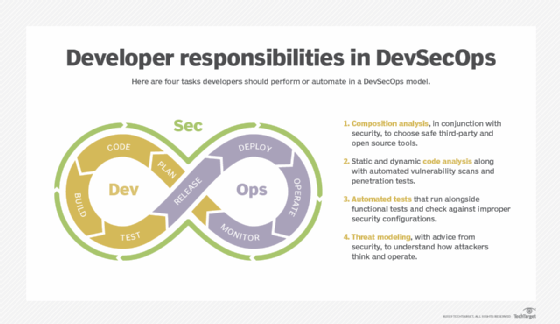DevOps is the combination of cultural philosophies, practices, and tools that increases an organization's ability to deliver applications and services at high velocity: evolving and improving products at a faster pace than organizations using traditional software development and infrastructure management processes.
The DevOps lifecycle consists of six phases representing the processes, capabilities, and tools needed for development (on the left side of the loop) and operations (on the right side of the loop). Throughout each phase, teams collaborate and communicate to maintain alignment, velocity, and quality.

Methodologies, principles and strategies
DevOps is associated with Agile software development because Agile practitioners promoted DevOps as a way to extend the methodology into production. The approach has even been labeled a counterculture to the IT service management practices championed in ITIL. DevOps does not have an official framework. To hone their strategies, organizations should understand the related contexts of DevOps, Agile and Waterfall development, site reliability engineering (SRE) and SysOps, and even the variations within DevOps.
DevOps vs. Waterfall development. Waterfall development comprises a series of steps and gates in a linear progression to production. Its phases are requirements, analysis, design, coding and implementation, testing, operation and deployment and maintenance. In Waterfall teams, development tests new code in an isolated environment for quality assurance (QA) and -- if requirements are met -- releases the code to operations for use in production. IT operations deploys multiple releases at once, with extensive controls. Support is operations' responsibility. Waterfall approaches engender long waits between software releases. Because development and operations teams work separately, developers are not always aware of operational roadblocks that prevent code from working as anticipated.
The DevOps model aligns development, QA and IT operations efforts with fewer gates and more continuous workflow. For example, some of the operations' team responsibilities shift left in the app delivery pipeline to the development team. IT operations provides feedback for code improvements. Rather than gated steps, DevOps relies on continuous development, continuous integration, continuous delivery and continuous monitoring processes.
DevOps vs. Agile development. Agile is a software development approach defined in the Agile Manifesto. Agile teams focus on incremental and rapid cycles of code creation and delivery, referred to as sprints. Each sprint iterates upon the last, which creates a high level of flexibility in the software and adapts to changing requirements. It is possible for the original vision of a project to be lost through this cycle.
DevOps arose from Agile's success at improving development speed, when it became clear that disconnects between development and operations teams -- as well as between IT and the business side of the organization -- significantly hindered the Agile software's delivery to users.
In an Agile-only workflow, development and operations teams have separate objectives and leadership. When an organization uses DevOps and Agile together, both development and operations teams manage code throughout the software development lifecycle. While Agile work is often formalized with a framework, such as Scrum, DevOps does not have a framework.
DevOps vs. SRE. Site reliability engineering arose concurrently with Agile and DevOps. Started in the early 2000s at Google, it is essentially a programming- and automation-focused approach to the software development lifecycle. Problems should be solved in a way that prevents them from occurring again. Rote tasks should be minimized.
The SRE toolbox closely matches that for DevOps. Both disciplines aim for continuous improvement. SRE and DevOps engineers seek to abolish silos between development and operations. While DevOps also can extend to business stakeholders, SRE typically stays within the confines of IT processes.
DevOps vs. SysOps. SysOps typically denotes an IT administrator or IT team managing production deployment and support for a large, distributed application, such as a SaaS product. As with DevOps adopters, SysOps teams should be versed in cloud computing and automation, as well as other technologies that enable applications to perform well at a large scale. SysOps teams troubleshoot IT outages and incidents, monitor for performance problems, enforce security rules and optimize operations.
They focus on high availability, fault tolerance, security and performance just like other IT admins. While SysOps professionals are likely to use some development tools and understand development processes, their work is not as enmeshed with development as in a DevOps job. However, SysOps roles can exist within DevOps and SRE organizations.
DevOps vs. DevOps. Some organizations broaden the scope of DevOps to include other departments. In DevSecOps, security planning, scans, testing and reviews occur continuously throughout the DevOps loop. BizDevOps focuses on connecting executives, application owners and other business stakeholders to the technical team, which develops, tests and supports the software. While more collaboration is arguably always better than less, these collaborators must share effective, timely and precise input.
